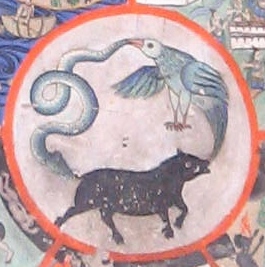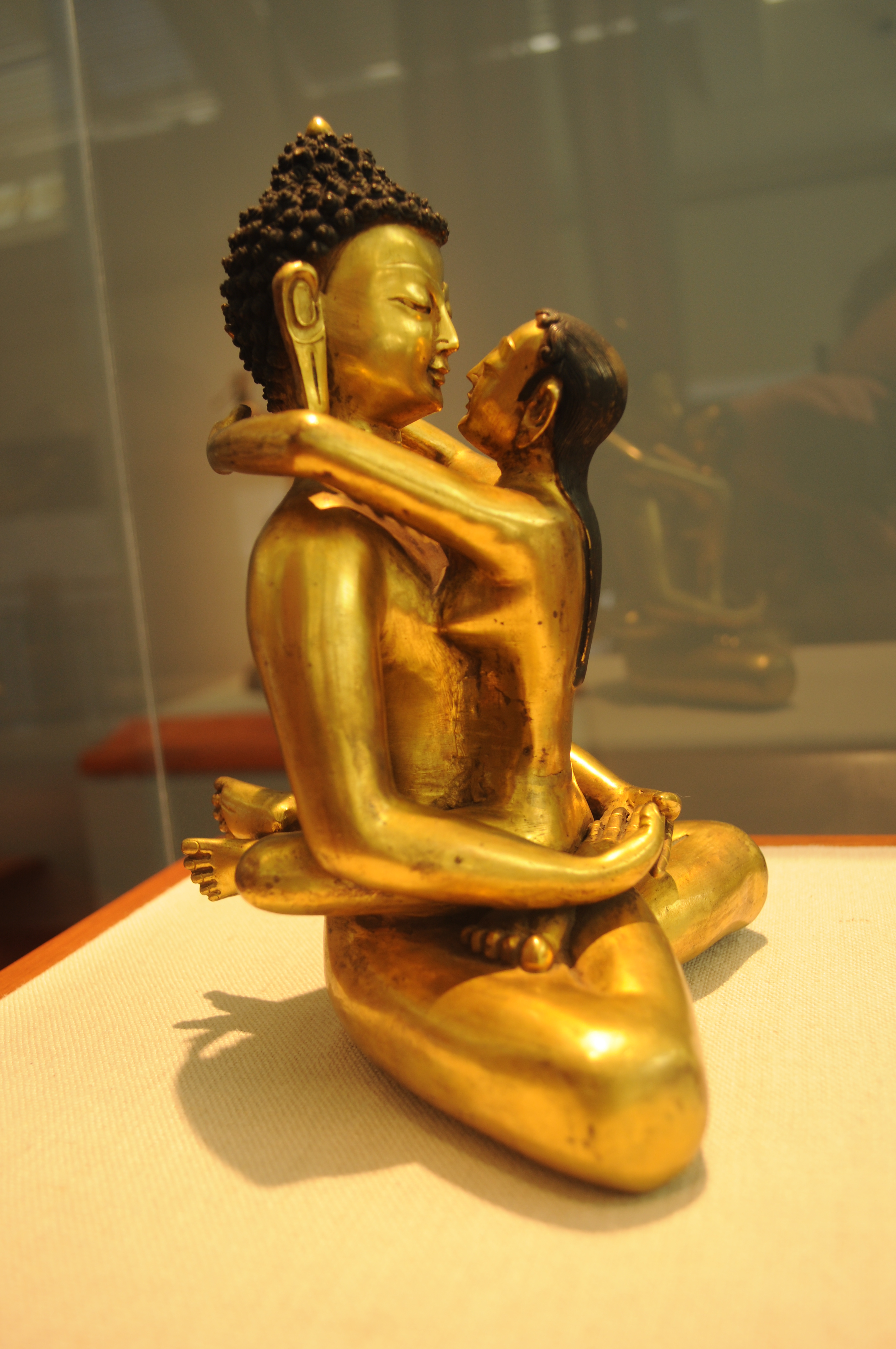|
Gankyil
The Gankyil (, Lhasa ) or "wheel of joy" ( sa, ānanda- cakra) is a symbol and ritual tool used in Tibetan and East Asian Buddhism. It is composed of three (sometimes two or four) swirling and interconnected blades. The traditional spinning direction is clockwise (right turning), but the counter-clockwise ones are also common. The gankyil as inner wheel of the dharmachakra is depicted on the Flag of Sikkim, Joseon, and is also depicted on the Flag of Tibet and Emblem of Tibet. Exegesis In addition to linking the gankyil with the "wish-fulfilling jewel" (Skt. cintamani), Robert Beer makes the following connections: The "victory" referred to above is symbolised by the dhvaja or "victory banner". Wallace (2001: p. 77) identifies the ''ānandacakra'' with the heart of the "cosmic body" of which Mount Meru is the epicentre: Associated triunes Ground, path, and fruit * " ground", "base" () * "path", "method" () * "fruit", "product" () Three humours of traditional Ti ... [...More Info...] [...Related Items...] OR: [Wikipedia] [Google] [Baidu] |
Yin And Yang
Yin and yang ( and ) is a Chinese philosophy, Chinese philosophical concept that describes opposite but interconnected forces. In Chinese cosmology, the universe creates itself out of a primary chaos of material energy, organized into the cycles of yin and yang and formed into objects and lives. Yin is the receptive and yang the active principle, seen in all forms of change and difference such as the annual cycle (winter and summer), the landscape (north-facing shade and south-facing brightness), sexual coupling (female and male), the formation of both men and women as characters and sociopolitical history (disorder and order). Taiji (philosophy), Taiji or Tai chi () is a Chinese cosmological term for the "Supreme Ultimate" state of undifferentiated absolute and infinite potential, the oneness before duality, from which yin and yang originate. It can be compared with the old ''Wuji (philosophy), wuji'' (, "without pole"). In the cosmology pertaining to yin and yang, the mate ... [...More Info...] [...Related Items...] OR: [Wikipedia] [Google] [Baidu] |
Three Poisons (Buddhism)
The three poisons (Sanskrit: ''triviṣa''; Tibetan: ''dug gsum'') or the three unwholesome roots (Sanskrit: ''akuśala-mūla''; Pāli: ''akusala-mūla''), in Buddhism, refer to the three root kleshas: '' Moha'' (delusion, confusion), ''Raga'' (greed, sensual attachment), and ''Dvesha'' (aversion, hate). These three poisons are considered to be three afflictions or character flaws innate in a being, the root of ''Taṇhā'' (craving), and thus in part the cause of '' Dukkha'' (suffering, pain, unsatisfactoriness) and rebirths. The three poisons are symbolically drawn at the center of Buddhist ''Bhavachakra'' artwork, with rooster, snake, and pig, representing greed, ill will, and delusion respectively. Brief description In the Buddhist teachings, the three poisons (of ignorance, attachment, and aversion) are the primary causes that keep sentient beings trapped in samsara. These three poisons are said to be the root of all of the other kleshas. The three poisons are represente ... [...More Info...] [...Related Items...] OR: [Wikipedia] [Google] [Baidu] |
Wisdom In Buddhism
Wisdom, sapience, or sagacity is the ability to contemplate and act using knowledge, experience, understanding, common sense and insight. Wisdom is associated with attributes such as unbiased judgment, compassion, experiential self-knowledge, self-transcendence and non-attachment, and virtues such as ethics and benevolence. Wisdom has been defined in many different ways, including several distinct approaches to assess the characteristics attributed to wisdom. Definitions The ''Oxford English Dictionary'' defines wisdom as "Capacity of judging rightly in matters relating to life and conduct; soundness of judgment in the choice of means and ends; sometimes, less strictly, sound sense, esp. in practical affairs: opp. to folly;" also "Knowledge (esp. of a high or abstruse kind); enlightenment, learning, erudition." Charles Haddon Spurgeon defined wisdom as "the right use of knowledge". Robert I. Sutton and Andrew Hargadon defined the "attitude of wisdom" as "acting with knowle ... [...More Info...] [...Related Items...] OR: [Wikipedia] [Google] [Baidu] |
Pitta (dosha)
Pittas are a family, Pittidae, of passerine birds found in Asia, Australasia and Africa. There are thought to be 40 to 42 species of pittas, all similar in general appearance and habits. The pittas are Old World suboscines, and their closest relatives among other birds are in the genera ''Smithornis '' and ''Calyptomena''. Initially placed in a single genus, as of 2009 they have been split into three genera: ''Pitta'', ''Erythropitta'' and ''Hydrornis''. Pittas are medium-sized by passerine standards, at in length, and stocky, with strong, longish legs and long feet. They have very short tails and stout, slightly decurved bills. Many have brightly coloured plumage. Most pitta species are tropical; a few species can be found in temperate climates. They are mostly found in forests, but some live in scrub and mangroves. They are highly terrestrial and mostly solitary, and usually forage on wet forest floors in areas with good ground cover. They eat earthworms, snails, insects an ... [...More Info...] [...Related Items...] OR: [Wikipedia] [Google] [Baidu] |
Vata (dosha)
Vata may refer to: People *Vata (noble), 11th-century Hungarian chieftain *Vata, Bishop of Várad, 12th-century Hungarian prelate *Vata Matanu Garcia, former Angolan football striker *Fatmir Vata (born 1971), Albanian footballer *Rudi Vata (born 1969), Albanian footballer and manager Places *Vata, Central African Republic *Vața, a village in Vedea Commune, Argeș County, Romania *Vața de Jos, a commune in Hunedoara County, Romania, and its village of Vața de Sus In religion *Vāta, another name for Vāyu, Hindu deity, lord of the winds, father of Bhima *A particular Zoroastrian divinity, one half of the pair Vata-Vayu Other uses * ''Vata'' (beetle), a genus of ground beetles in the family Carabidae *Vata pagan uprising, a Hungarian rebellion in 1046 *A dialect of the Dida language spoken in Ivory Coast *One of the three elemental substances, or doshas, of the Ayurveda Ayurveda () is an alternative medicine system with historical roots in the Indian subcontinent. The theor ... [...More Info...] [...Related Items...] OR: [Wikipedia] [Google] [Baidu] |
Lung (Tibetan Buddhism)
Lung ( ''rlung'') means wind or breath. It is a key concept in the Vajrayana traditions of Tibetan Buddhism and has a variety of meanings. ''Lung'' is a concept that is particularly important to understandings of the subtle body and the trikaya (body, speech and mind). Traditional Tibetan medicine practitioner Dr. Tamdin Sither Bradley provides a summary: Usages Some of the different usages of the term ''lung'' include: * the psychic winds (sanskrit: ''prana'') that travel in the internal channels, or ''nadi'' (Sanskrit) of the subtle body and are manipulated in certain Vajrayana yoga practices. * specifically the five psychic winds that are a manifestation of the mahābhūta. These five are the lifeforce that animate the bodymind (Sanskrit: ''namarupa'') of all sentient beings and are key to certain tantric Buddhist and Bon sādhanās and traditional Tibetan medicine. * to the vayu and prana of ayurveda. * as a component of the term for a type of prayer flag, named after the a ... [...More Info...] [...Related Items...] OR: [Wikipedia] [Google] [Baidu] |
Ayurveda
Ayurveda () is an alternative medicine system with historical roots in the Indian subcontinent. The theory and practice of Ayurveda is pseudoscientific. Ayurveda is heavily practiced in India and Nepal, where around 80% of the population report using it. Ayurveda therapies have varied and evolved over more than two millennia. Therapies include herbal medicines, special diets, meditation, yoga, massage, laxatives, enemas, and medical oils. Ayurvedic preparations are typically based on complex herbal compounds, minerals, and metal substances (perhaps under the influence of early Indian alchemy or ''rasashastra''). Ancient Ayurveda texts also taught surgical techniques, including rhinoplasty, kidney stone extractions, sutures, and the extraction of foreign objects. The main classical Ayurveda texts begin with accounts of the transmission of medical knowledge from the gods to sages, and then to human physicians. Printed editions of the '' Sushruta Samhita'' (''Sushruta's Compen ... [...More Info...] [...Related Items...] OR: [Wikipedia] [Google] [Baidu] |
Ground (Dzogchen)
In Dzogchen, the ground or base () is the primordial state. It is an essential component of the Dzogchen tradition for both the Bon tradition and the Nyingma school of Tibetan Buddhism. Knowledge of this ''ground'' is called ''rigpa''. Explication A key concept in Dzogchen is the 'basis', 'ground' or 'primordial state' (Tibetan: གཞི་ ''gzhi''), also called the general ground (སྤྱི་གཞི་ ''spyi gzhi'') or the original ground (གདོད་མའི་གཞི་ ''gdod ma'i gzhi''). The basis is the original state "before realization produced buddhas and nonrealization produced sentient beings". It is atemporal and unchanging and yet it is "noetically potent", giving rise to mind (སེམས་ ''sems,''), consciousness (ཤེས་པ་ ''shes pa''), delusion (མ་རིག་པ་ ''marigpa'') and knowledge (རིག་པ་་''rigpa''). Furthermore, Hatchell notes that the Dzogchen tradition portrays ultimate reality as something which is " ... [...More Info...] [...Related Items...] OR: [Wikipedia] [Google] [Baidu] |
Mount Meru
Mount Meru (Sanskrit/Pali: मेरु), also known as Sumeru, Sineru or Mahāmeru, is the sacred five-peaked mountain of Hindu, Jain, and Buddhist cosmology and is considered to be the centre of all the physical, metaphysical and spiritual universes. There is no clear identification of Mount Meru with a particular geophysical location. Many famous Buddhist, Jain, and Hindu temples have been built as symbolic representations of this mountain. The "Sumeru Throne" 須彌座 xūmízuò style base is a common feature of Chinese pagodas. The highest point (the finial bud) on the pyatthat, a Burmese-style multi-tiered roof, represents Mount Meru. Etymology Etymologically, the proper name of the mountain is Meru (Sanskrit: Meru), to which is added the approbatory prefix su-, resulting in the meaning "excellent Meru" or "wonderful Meru". ''Meru'' is also the name of the central bead in a mālā. In other languages In other languages, Mount Meru is pronounced: * Assamese: � ... [...More Info...] [...Related Items...] OR: [Wikipedia] [Google] [Baidu] |
Dhvaja
Dhvaja (Sanskrit also ध्वज; ) , meaning banner or flag, is composed of the Ashtamangala, the "eight auspicious symbols". In Hinduism Dhvaja in Hinduism or vedic tradition takes on the appearance of a high column (dhvaja-stambha) erected in front of temples. Dhvaja, meaning a flag banner, was a military standard of ancient Indian warfare. Notable flags, belonging to the Gods, are as follows: *Garuda Dhwaja – The flag of Vishnu. *Indra Dhwaja – The flag of Indra. Also a festival of Indra. *Kakkai kodi – The flag of Jyestha (goddess), Jyestha, goddess of inauspicious things and misfortune. *Kapi Dhwaja or ''Vanara dwaja (Vanara = Vana + Nara, Flag of the Man of the forest)'' – The flag of Arjuna in the Mahabharata, in which the Lord Hanuman himself resided.Sri Ramakrishna Math (1985) "Hanuman Chalisa" p. 9 *Makaradhvaja – The flag of Kama, god of love. *Seval Kodi – The war flag of Lord Murugan, god of war. It depicts the rooster, ''Krichi''. Tibetan architec ... [...More Info...] [...Related Items...] OR: [Wikipedia] [Google] [Baidu] |
Robert Beer
The name Robert is an ancient Germanic given name, from Proto-Germanic "fame" and "bright" (''Hrōþiberhtaz''). Compare Old Dutch ''Robrecht'' and Old High German ''Hrodebert'' (a compound of '' Hruod'' ( non, Hróðr) "fame, glory, honour, praise, renown" and ''berht'' "bright, light, shining"). It is the second most frequently used given name of ancient Germanic origin. It is also in use as a surname. Another commonly used form of the name is Rupert. After becoming widely used in Continental Europe it entered England in its Old French form ''Robert'', where an Old English cognate form (''Hrēodbēorht'', ''Hrodberht'', ''Hrēodbēorð'', ''Hrœdbœrð'', ''Hrœdberð'', ''Hrōðberχtŕ'') had existed before the Norman Conquest. The feminine version is Roberta. The Italian, Portuguese, and Spanish form is Roberto. Robert is also a common name in many Germanic languages, including English, German, Dutch, Norwegian, Swedish, Scots, Danish, and Icelandic. It can be use ... [...More Info...] [...Related Items...] OR: [Wikipedia] [Google] [Baidu] |
Chakravartin
A ''chakravarti'' ( sa, चक्रवर्तिन्, ''cakravartin''; pi, cakkavatti; zh, 轉輪王, ''Zhuǎnlúnwáng'', "Wheel-Turning King"; , ''Zhuǎnlún Shèngwáng'', "Wheel-Turning Sacred King"; ja, 転輪王, ''Tenrin'ō'' or , ''Tenrinjōō'') is an ideal (or idealized) universal ruler, in Indian history, the history, Dharmic religion, religion, and mythologies of India. The concept is present in the cultural traditions Vedic mythology, of Vedic, Hindu mythology, Hindu, Jainism, Jain and Buddhist mythology, Buddhist narrative myths and lore. There are three types of chakravarti: ''chakravala chakravarti'', a king who rules over all four of the continents (i.e., a universal monarch); ''dvipa chakravarti'', a ruler who governs only one of those continents; and ''pradesha chakravarti'', a monarch who leads the people of only a part of a continent, the equivalent of a local king. Dvipa chakravarti is particularly one who rules the entire Indian subcontinent (as ... [...More Info...] [...Related Items...] OR: [Wikipedia] [Google] [Baidu] |







